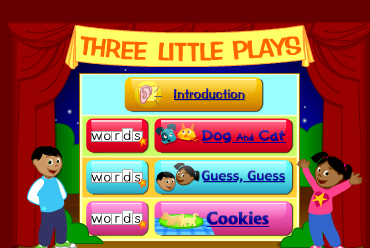|
3.1 Distinguish fantasy from realistic text.
3.2 Identify types of everyday print materials (e.g., storybooks, poems, newspapers,
signs, labels).
3.3 Identify characters, settings, and important events.
| Teach |
Practice |
Assess |
| |

Plays |
|
| |
|
|
|
|
3.1 Identify and describe the elements of plot, setting, and character(s) in a story, as well as the story’s beginning, middle, and ending.
3.2 Describe the role of authors and illustrators and their contributions to print materials.
3.3 Recollect, talk, and write about books read during the school year.
|
blueprint 9%
3.1 2 Compare and contrast plots, settings, and characters presented by different authors.
3.2 1 Generate alternative endings to plots and identify the reason or reasons for, and the impact of, the alternatives.
3.31 Compare and contrast different versions of the same stories that reflect different cultures.
3.4 2 Define figurative language (e.g., simile, metaphor, hyperbole, personification) and
identify its use in literary works.
|
blueprint 12%
3.1 1 Distinguish common forms of literature (e.g., poetry, drama, fiction, nonfiction).
3.2 2 Comprehend basic plots of classic fairy tales, myths, folktales, legends, and fables from
around the world.
3.32 Determine what characters are like by what they say or do and by how the author or illustrator portrays them.
3.4 1 Compare and contrast tales from different cultures by tracing the exploits of one character
type and develop theories to account for similar tales in diverse cultures (e.g., trickster
tales).
3.51 Recognize the similarities of sounds in words and rhythmic patterns (e.g., alliteration,
onomatopoeia) in a selection.
3.6 1 Identify the speaker or narrator in a selection.
|
blueprint 12%
3.1 1 Describe the structural differences of various imaginative forms of literature, including
fantasies, fables, myths, legends, and fairy tales.
3.2 2 Identify the main events of the plot, their causes, and the influence of each event onfuture actions.
3.31 Use knowledge of the situation and setting and of a character’s traits and motivations to
determine the causes for that character’s actions.
3.4 2 Clarify an understanding of texts by creating outlines, logical notes, summaries, or reports.
|
blueprint 16%
3.1 1 Identify the analyze the characteristics of poetry, drama, fiction and nonfiction, and explain the appropriateness of the literary forms chosen by the author for a specific purpose.
3.2 2 Identify the main problem or conflict of the plot and explain how it is resolved.
3.32 Contrast the actions, motives (e.g., loyalty, selfishness, conscientiousness), and appearances
of characters in a work of fiction and discuss the importance of the contrasts to the plot or theme.
3.4 2 Contrast the actions, motives (e.g., loyalty, selfishness, conscientiousness), and appearances
of characters in a work of fiction and discuss the importance of the contrasts to the
plot or theme.
3.52 Describe the function and effect of common literary devices (e.g., imagery, metaphor,
symbolism).
3.6 2 Evaluate the meaning of archetypal patterns and symbols that are found in myth and tradition by using literature from different eras and cultures.
3.7 2 Evaluate the author’s use of various techniques (e.g., appeal of characters in a picture book, logic and credibility of plots and settings, use of figurative language) to influence
readers’ perspectives.
|
blueprint 16%
3.1 1 Identify the forms of fiction and describe the major characteristics of each form.
3.2 2 Analyze the effect of the qualities of the character (e.g., courage or cowardice, ambition
or laziness) on the plot and the resolution of the conflict.
3.31 Analyze the influence of setting on the problem and its resolution.
3.4 3 Define how tone or meaning is conveyed in poetry through word choice, figurative
language, sentence structure, line length, punctuation, rhythm, repetition, and rhyme.
3.5 1 Identify the speaker and recognize the difference between first- and third-person narration
(e.g., autobiography compared with biography).
3.6 1 Identify and analyze features of themes conveyed through characters, actions, and images.
3.7 2 Explain the effects of common literary devices (e.g., symbolism, imagery, metaphor) in a
variety of fictional and nonfictional texts.
3.8 1 Critique the credibility of characterization and the degree to which a plot is contrived or
realistic (e.g., compare use of fact and fantasy in historical fiction).
|
|